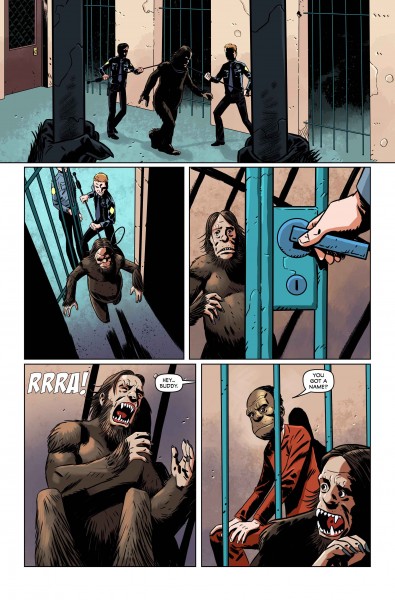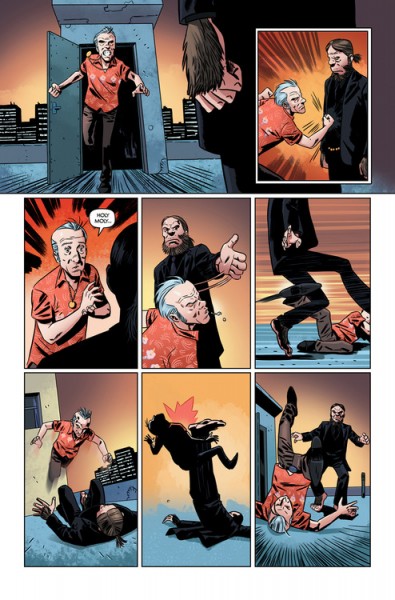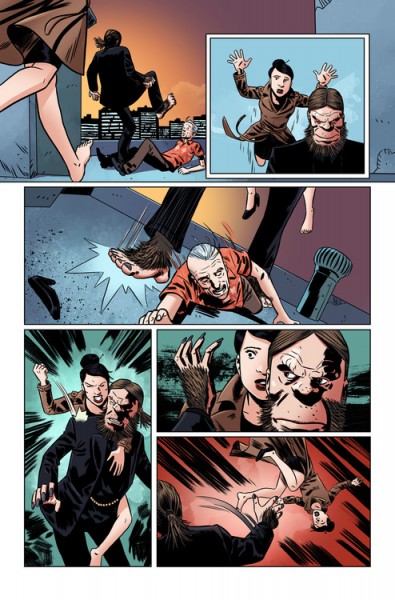Strange Nation #3 Review: Atypically Entertaining
Norma Park isn’t your typical reporter—then again, she isn’t writing for your typical newspaper. Nor is she working with a typical partner, or investigating a typical company or a typical town. In fact, there isn’t much that’s typical about this fiercely original comic from Monkeybrain. Norma Park occupies a strange world that just keeps on getting stranger, and I don’t think she’d have it any other way. I know I wouldn’t.
Paul Allor and the rest of the creative team do a great job at packing a good amount of story development into a limited number of pages. Issues of
Strange Nation always feel so unfortunately short. That isn’t so much a complaint as it is a strong desire to keep reading, as the stakes were raised exceptionally high in the first issue, and they’ve creeped higher every issue since.

I said it before and I’ll say it again:
Strange Nation reads like a superhero comic. For one, Norma has a sidekick who just so happens to be intimately linked with the world of conspiracies, which gives their relationship a fighting fire with fire type of feel. Additionally, the enemy is formidable; it exists closer to home than Norma could ever imagine, and it’s dangerous. Finally, Norma’s pursuit of facts for the purpose of publication and exposure is as detrimental to the enemy as any licking that a superhero could lay; for conspiracies, exposure is defeat, so an investigative reporter actually
is the oil to their proverbial water.
For me, the icing on the cake is that a serious reporter who cares about her work is ten times as believable as a masked avenger crusading for evil—not that “believable” is necessarily a virtue in comic books; I just always prefer a protagonist whose motivations are clear. And while what she’s after is the farthest thing from “believable,” Norma is a journalist, and the more unbelievable something might sound, the better the story. I guess what I’m trying to say is that Norma Park has my unwavering support. I care about her and her work, and I’ll eagerly anticipate her upcoming exploits.

Paul Allor has done a magnificent job with writing
Strange Nation. When I read it, I can’t help but look towards a future that, perhaps, even he hasn’t considered yet. The world he’s developing is both deep and rich with potential. I could see countless spinoffs being set in the very same universe, where sasquatches are brainwashed pawns and test subjects, where entire towns are in on cover-ups, and where UFOs—well, I won’t say too much more. I will say this though: I’d love to see more Jesse and all that he’s done since that fateful day in August of 1977.
Juan Romera’s artwork is a big reason why this comic feels like a hero’s tale. On the surface, you wouldn’t think an investigative reporter would have to spend much time running and fighting for her life. However, that’s just the case in
Strange Nation, and Romera is very skilled at putting this action in pictures. And for a style that compromises realism for hard color contrasts in a way that feels more like a cartoon, his facial expressions are exceptionally effective. It’s a job well done.

It’s incredibly refreshing to see an against all odds hero who doesn’t solve every problem with her fists. That’s that fierce originality I was talking about earlier. While I might be attempting to classify this comic as being a part of this or that genre, it is every bit a detective’s tale as it is a superhero story. In fact, it eludes those arbitrary distinctions and maintains the best of both worlds. If Allor and company continue to explore and develop the world of this story in the ways it’s beginning to demand,
Strange Nation will need it’s own wiki.
Pros
- Interesting and diverse character cast that keeps growing
- Rich universe begging to be explored
- Well paced and eventful
Cons
- Dialogue is a bit too expository
- Characters lack unique dialogue queues/ all speak similarly
 Paul Allor has done a magnificent job with writing Strange Nation. When I read it, I can’t help but look towards a future that, perhaps, even he hasn’t considered yet. The world he’s developing is both deep and rich with potential. I could see countless spinoffs being set in the very same universe, where sasquatches are brainwashed pawns and test subjects, where entire towns are in on cover-ups, and where UFOs—well, I won’t say too much more. I will say this though: I’d love to see more Jesse and all that he’s done since that fateful day in August of 1977.
Juan Romera’s artwork is a big reason why this comic feels like a hero’s tale. On the surface, you wouldn’t think an investigative reporter would have to spend much time running and fighting for her life. However, that’s just the case in Strange Nation, and Romera is very skilled at putting this action in pictures. And for a style that compromises realism for hard color contrasts in a way that feels more like a cartoon, his facial expressions are exceptionally effective. It’s a job well done.
It’s incredibly refreshing to see an against all odds hero who doesn’t solve every problem with her fists. That’s that fierce originality I was talking about earlier. While I might be attempting to classify this comic as being a part of this or that genre, it is every bit a detective’s tale as it is a superhero story. In fact, it eludes those arbitrary distinctions and maintains the best of both worlds. If Allor and company continue to explore and develop the world of this story in the ways it’s beginning to demand, Strange Nation will need it’s own wiki.
Paul Allor has done a magnificent job with writing Strange Nation. When I read it, I can’t help but look towards a future that, perhaps, even he hasn’t considered yet. The world he’s developing is both deep and rich with potential. I could see countless spinoffs being set in the very same universe, where sasquatches are brainwashed pawns and test subjects, where entire towns are in on cover-ups, and where UFOs—well, I won’t say too much more. I will say this though: I’d love to see more Jesse and all that he’s done since that fateful day in August of 1977.
Juan Romera’s artwork is a big reason why this comic feels like a hero’s tale. On the surface, you wouldn’t think an investigative reporter would have to spend much time running and fighting for her life. However, that’s just the case in Strange Nation, and Romera is very skilled at putting this action in pictures. And for a style that compromises realism for hard color contrasts in a way that feels more like a cartoon, his facial expressions are exceptionally effective. It’s a job well done.
It’s incredibly refreshing to see an against all odds hero who doesn’t solve every problem with her fists. That’s that fierce originality I was talking about earlier. While I might be attempting to classify this comic as being a part of this or that genre, it is every bit a detective’s tale as it is a superhero story. In fact, it eludes those arbitrary distinctions and maintains the best of both worlds. If Allor and company continue to explore and develop the world of this story in the ways it’s beginning to demand, Strange Nation will need it’s own wiki.